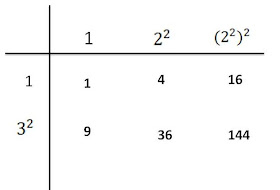
Learn basic facts here.
Another fun trick is to find the total number of factors any number has. To do this, take the prime factorization of the number, add 1 to each of the exponents of the prime factor, and multiply these new numbers together.
Example:
#1: 12 = 22 x 31
(2+1) x (1+1) = 3 x 2 = 6
Therefore, 12 has 6 factors. {1, 2, 3, 4, 6, 12}
#2: 8= 23 , (3+1) = 4 Therefore, 8 has 4 factors. {1, 2, 4, 8}
Problems to ponder: answers and solutions below.
1. What is the smallest number with 5 factors?
2. What is the smallest number with 6 factors?
3. What is the smallest number with 12 factors?
4. How many factors does any prime number have?
5. How many even factors does 36 have? (tricky question)
6. How many perfect square factors does 144 have? ( don’t just list them, think how you get the answers)
Answers:
1. 16 Since 5 itself is a prime, the smallest number that has 5 factors would look like this: n4 put in the smallest prime number and the answer is 24 = 16
2. 12 The number 6 can be factor as 6 x 1 or 3 x 2 so you can have either n5 or x2 * y1
so either 25 or 22 * 3 so the answer is 12.
3. 60 12 = 12 x 1 = 6 x 2 = 4 x 3 = 3 x 2 x 2 The last would give you the smallest number which is
22 * 31 * 51 = 60
4. 2 Any prime number has two factors, which are 1 and itself. The smallest prime number is 2, which is the oddest prime -- the only even number that is a prime. (Why??)
5. 6 Any even number multiples another integer will give you another even number. To get only even factors, you need to always leave the smallest even number, which is 2, with all the other factors.
36 = 22 * 32
= 2 (21 *32) There are(1 + 1) ( 2 + 1 ) = 6 even factors
6. 6 The number 144 = 24 * 32
To get only square factors, you need to keep the smallest square number of all the prime numbers, leave out the others that are not square and find how many factors that new arrangement has.
( 22)2 * (32)1 There are (2 + 1) ( 1 + 1)= 6 square factors.
See what they are on the left.
